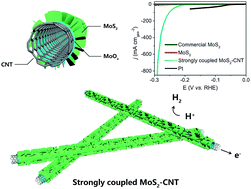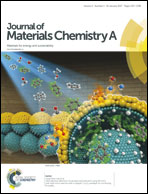Strongly coupled MoS2 nanoflake–carbon nanotube nanocomposite as an excellent electrocatalyst for hydrogen evolution reaction†
Abstract
As a promising non-precious metal electrocatalyst for the hydrogen evolution reaction (HER), MoS2 suffers from impeded electrical conductivity and scarce active sites. This tricky situation can be ameliorated but not eliminated by the simple involvement of nanocarbons. Herein, a leaves-and-branch structure of strongly coupled and porous MoS2–carbon nanotube (CNT) nanocomposite was synthesized, where few-layer MoS2 nanoflakes are anchored radially and intimately on the surface of CNT. Mo–O–C has been unveiled to be the bridge between these two phases and a sandwich-like structure was proposed for the interface within the strongly coupled MoS2–CNT. This genuine nanocomposite exhibits remarkably improved electrocatalytic activity towards HER, reaching −850 mA cmgeo−2 with the expense of only 290 mV of overpotential and maintaining a low Tafel slope of 47 mV per decade even under a current density of 100 mA cmgeo−2. After detailed analysis, this surging activity has been ascribed not so much to the simple addition of the properties of MoS2 and CNT, but to a strong interfacial attachment between them which not only stabilizes tiny and edge-terminated MoS2 nanoflakes, but also constructs a three dimensional hierarchical structure to boost electron and mass transfer during the HER operation.


 Please wait while we load your content...
Please wait while we load your content...